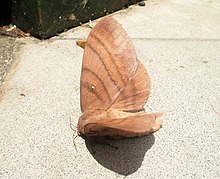Kunugia latipennis
Appearance
| Kunugia latipennis | |
|---|---|

| |
| Scientific classification | |
| Kingdom: | |
| Phylum: | |
| Class: | |
| Order: | |
| Family: | |
| Genus: | |
| Species: | K. latipennis
|
| Binomial name | |
| Kunugia latipennis Walker, 1855
| |
| Synonyms | |
| |
Kunugia latipennis, the pine lappet moth, is a moth of the family Lasiocampidae. The species was first described by Francis Walker in 1855.[1]
Distribution
It is found in the Indian subregion, Sri Lanka,[2] Thailand, Vietnam, Myanmar, Sumatra, Borneo and Palawan.[3]
Biology
The caterpillar is a major pest on pines. An outbreak of pine lappet moths was observed in the mid-altitude hills of Meghalaya, India, during May and June 2011.[4] It is known to attack Pinus kesiya, Cupressus, Eucalyptus camaldulensis, Litchi chinensis, Mangifera indica, Mesua ferrea, Pinus elliottii, Pinus markusii, Shorea robusta, Syzygium cumini and Woodfordia fruticosa.[5]
References
- ^ "Species Details: Kunugia latipennis Walker, 1855". Catalogue of Life. Retrieved 2 March 2018.
- ^ Koçak, Ahmet Ömer; Kemal, Muhabbet (20 February 2012). "Preliminary list of the Lepidoptera of Sri Lanka". Cesa News (79): 1–57 – via Academia.
- ^ "Kunugia latipennis (Walker)". Digital Moths of Japan. Retrieved 2 March 2018.
- ^ Firake, D. M.; Behere, G. T.; Firake, P. D.; Thakur, N. S. Azad; Dubal, Z. B. (July 2012). "An outbreak of pine lappet moth, Kunugia latipennis, in mid-altitude hills of Meghalaya state, India". Phytoparasitica. 40 (3): 231–234. doi:10.1007/s12600-012-0228-2.
- ^ "HOSTS - a Database of the World's Lepidopteran Hostplants". The Natural History Museum. Retrieved 2 March 2018.
External links
